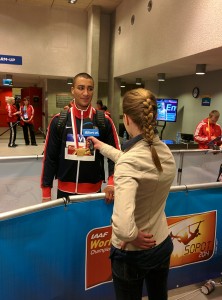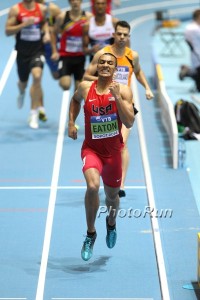Could a Little More Distance Training Earned Ashton Eaton $50,000? Eaton Wins World Heptathlon Title In Almost World Record Missing It By 1.18 Seconds
by LetsRun.com
March 7, 2014
Sopot, Poland – For the fourth straight global championship, Ashton Eaton is your World multi-event champion. On day 2 of the 2014 World Indoor Track and Field Championships in Sopot Poland, he finished with 6632 points to defend his title and add yet another gold medal to his collection. An amazing stat is that Eaton has broken the world record in his last three heptathlons and if he had done it here it would have been four.
Unfortunately, it wasn’t meant to be as Eaton fell just 14 points short of breaking his own world record as the record attempt came down to the last event, the 1000m. Going in, Eaton was ahead of WR pace and if he could run his PR of 2:32.67 or even .87-seconds off it, he’d have the WR and the $50,000 bonus from the IAAF that went with it. However,Eaton finished in 2:34.72 (still more than 3-seconds ahead of his nearest competitor) and missed the WR.
 Ashton Eaton with the Polish press at Sopot 2014
Ashton Eaton with the Polish press at Sopot 2014
Considering, Eaton is the Olympic, World Outdoor and now two-time defending World Indoor champion, not to mention the WR holder in both the heptathlon and decathlon, he and coach Harry Mara clearly know how to train. But could a little bit more of distance training gotten Eaton the world record here? Or would the extra distance training cost him in another event?
The fact the WR chase came down to the 1000 definitely made it extra interesting for distance fans and raises the question, “What exactly does a multi-events star like Eaton do for distance training?” Eaton is one of the faster multi-eventers out there, so we took the opportunity to ask him about his distance training at the post-competition press conference.
He Trains For 10 Events But Distance Training Only Gets 1% Of His Time
Ashton started off the press conference saying, “Going into the 1000 meters, I knew what I had to do, but as the race started I thought, ‘Hmm, I’m a little more tired than I thought I was.’ So I was going slow and then I tried to motivate myself and said, ‘Ashton, stop being such a wimp, lets go!’ But by that time I think it was too late. So no world record now. I’ll save it for Portland 2016.” (Portland is hosting the 2016 World Indoor Championships.)
Eaton laughed when we told him that since the record chase did come down to the 1000, we thought some of the LRC visitors would be interested to hear what he did for mid-d training. He started off saying, “I’d say we put about 1% focus on distance training. Typically for our base as runners, it’s 400m-runner designed essentially.”
Looking at the decathlon, 3 events are straight up sprinting and 3 more involve sprinting. Only one event is mid-distance running, so basing everything off the 400 makes a lot of sense (to our little LRC distance minds).
Talking about some specific workouts Ashton said the typical workouts he does are 400m based and mentioned examples such as 3-4 x 250 with 4-minutes rest, 3 x 300sm and 150-200m hill repeats. While a mid-d guy might do similar workouts to that, they would just be part of a system that includes easy mileage, tempos and longer intervals. Eaton said the only mid-d training he does (and we’re not sure if we’d call it a mid-d workout) is what he called ‘100m repeats’. Eaton said, “I’ll run 100 meters, cross the line, and then turn around and keep doing it again and I’ll do it for like 800 meters.” He said that it wasn’t even for fitness as much as “rhythm of the run”. As a 400m guy he feels his stride is different and he wants it to be a little more “short and bouncy” in the distance events.
In the end, Eaton definitely didn’t feel it was lack of distance training that lost him the record today. He said, “Today it didn’t really come down to my fitness. I think it just came down to my mental toughness and maybe fatigue…”
He took some extra time and tried to try and put multi-event training into perspective for us and the rest of the press conference. He described it like this: you have 52-weeks in a year and with breaks he’s training about 40 of those. And then taking the hurdles for example, they’ll do one workout a week, so the entire year that’s 40 hurdle workouts and with breaks, competitions and travel in there, it could end up being more like 30. Obviously if you compare that to a one-event athlete it’s way less as they’ll do training specific to their event every day, which if they’re training 40-weeks a year or more, would be 280+ training sessions. Eaton said, “You’re possibly looking at 30-times hurdling, or pole vault or throwing the shot. And to come to a competition – especially indoor we’re obviously not looking at 30-weeks, we’re looking at a lot less – and to see some of these results, when you put it in perspective like that, I get wowed to look at some of the multi-event athletes.”
Eaton was very impressed with his competitors at this meet which included Belarus’ Andrei Krauchanka in second (6303-points) and Belgium’s Thomas Van Der Plaetsen in 3rd (6259-points) who both set national records.
Some Quick Stats On Eaton And The Heptathlon:
6 – The number of years since Ashton Eaton last competed in a heptathlon that he didn’t PR in. The last time was in March of 2008 when he finished 6th at NCAAs. As we mentioned above, before today Eaton had set the WR in his last three heptathlon competitions.
.38 – Even though Eaton ran 1.95-seconds slower in the 1000 than the last time he broke the heptathlon WR in 2012, he also long jumped .38m shorter. That was worth 97-points which obviously made a huge impact on the final score. The other 5 events (1000m and LJ aside) were better than or as good as he did in 2012.
2:27.88 – The heptathlon 1000m world record which is held by Duke alumn Curtis Beach set at the 2010 NCAA meet.
6870 – What the heptathlon WR would be if you took Eaton’s PR (indoors) from each of the 7 events. As mentioned above, the true WR is 6645, so this would be a 225-point improvement on that.
4- In the record books, the top 4 best heptathlon scores of all time are all from Ashton Eaton.
| Results: | ||||||||||||
|---|---|---|---|---|---|---|---|---|---|---|---|---|
| POS | BIB | ATHLETE | COUNTRY | POINTS | 60 METRES | LONG JUMP | SHOT PUT | HIGH JUMP | 60 METRES HURDLES | POLE VAULT | 1000 METRES | |
| 1 | Ashton EATON |  USA USA |
6632 WL | POINTS MARK WIND M/S |
1007 6.66 |
1005 7.78 |
782 14.88 |
859 2.06 |
1074 7.64 |
972 5.20 |
933 2:34.72 |
|
| 2 | Andrei KRAUCHANKA |  BLR BLR |
6303 NIR | POINTS MARK WIND M/S |
840 7.12 |
925 7.46 |
816 15.42 |
1002 2.21 |
957 8.10 |
910 5.00 |
853 2:41.88 |
|
| 3 | Thomas VAN DER PLAETSEN |  BEL BEL |
6259 NIR | POINTS MARK WIND M/S |
837 7.13 |
977 7.67 |
748 14.32 |
915 2.12 |
942 8.16 |
972 5.20 |
868 2:40.50 |
|
| 4 | Eelco SINTNICOLAAS |  NED NED |
6198 | POINTS MARK WIND M/S |
879 7.01 |
847 7.14 |
752 14.39 |
831 2.03 |
969 8.05 |
1035 5.40 |
885 2:38.98 |
|
| 5 | Oleksiy KASYANOV |  UKR UKR |
6176 SB | POINTS MARK WIND M/S |
925 6.88 |
945 7.54 |
815 15.41 |
831 2.03 |
1020 7.85 |
760 4.50 |
880 2:39.44 |
|
| 6 | Kai KAZMIREK |  GER GER |
6173 PB | POINTS MARK WIND M/S |
875 7.02 |
920 7.44 |
732 14.06 |
831 2.03 |
964 8.07 |
972 5.20 |
879 2:39.51 |
|
| 7 | Damian WARNER |  CAN CAN |
6129 PB | POINTS MARK WIND M/S |
973 6.75 |
888 7.31 |
720 13.86 |
803 2.00 |
1059 7.70 |
790 4.60 |
896 2:37.98 |
|
| 8 | Pascal BEHRENBRUCH |  GER GER |
4983 SB | POINTS MARK WIND M/S |
802 7.23 |
828 7.06 |
820 15.50 |
749 1.94 |
935 8.19 |
849 4.80 |
0 DNF |









